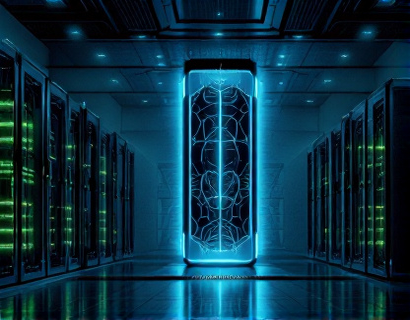Transforming Registry Management: The Power of Blockchain Technology
In an era where data integrity, security, and efficiency are paramount, the traditional methods of registry management are being revolutionized by blockchain technology. This article delves into how blockchain-powered registry solutions are redefining data management, offering unparalleled security, transparency, and efficiency. Whether you are a professional in the field of registry management, a data security advocate, or an IT and software development team member, understanding the transformative potential of blockchain in this domain is crucial.
Understanding Blockchain Technology
At its core, blockchain is a decentralized digital ledger that records transactions across multiple computers in such a way that the registered transactions cannot be altered retroactively. This technology ensures that once data is recorded, it is immutable and transparent, providing a robust framework for trust and accountability. The decentralized nature of blockchain means there is no single point of failure, making it highly resistant to cyber attacks and data breaches.
Enhanced Security in Registry Management
One of the most significant advantages of blockchain in registry management is the enhanced security it provides. Traditional registry systems are often centralized, making them vulnerable to hacking and data manipulation. Blockchain's distributed ledger technology (DLT) eliminates this risk by distributing data across a network of nodes, each maintaining a copy of the entire ledger. Any attempt to alter data in one node would require simultaneous alterations in all other nodes, which is computationally infeasible.
Moreover, blockchain employs advanced cryptographic techniques to secure data. Each block in the chain contains a cryptographic hash of the previous block, creating an unbreakable link. This ensures that any tampering with past transactions is immediately detectable, maintaining the integrity of the data. For professionals in data security, this means a significant reduction in the risk of data breaches and a higher level of trust in the registry systems they manage.
Transparency and Traceability
Blockchain's transparency is another key feature that transforms registry management. Every transaction or data entry is recorded in a transparent manner, visible to all participants in the network. This level of transparency fosters trust among stakeholders, as they can verify the authenticity and history of the data. For registry management professionals, this means that processes such as record-keeping, audits, and compliance checks become more straightforward and reliable.
Traceability is a direct result of transparency. With blockchain, each piece of data can be traced back to its origin, providing a clear and immutable audit trail. This is particularly valuable in industries where regulatory compliance is stringent, such as finance, healthcare, and supply chain management. The ability to trace data back to its source ensures that all records are accurate and tamper-proof, reducing the risk of fraud and errors.
Efficiency and Automation
Blockchain technology not only enhances security and transparency but also significantly improves the efficiency of registry management processes. Smart contracts, self-executing contracts with the terms directly written into code, automate routine tasks and reduce the need for intermediaries. For instance, in property registry management, smart contracts can automatically update ownership records upon the completion of a transaction, eliminating the need for manual paperwork and reducing processing times.
Automation through blockchain also streamlines workflows, reducing administrative burdens and costs. By eliminating manual steps and ensuring that all parties have real-time access to the same data, blockchain enables faster and more accurate decision-making. This is particularly beneficial for IT and software development teams, as it allows them to focus on more strategic tasks while routine operations are handled seamlessly by the blockchain system.
Case Studies and Real-World Applications
The potential of blockchain in registry management is not theoretical; it is being implemented in various sectors with tangible results. In the land registry sector, blockchain-based solutions have been deployed to create transparent and secure property records. For example, a pilot project in Estonia used blockchain to manage land registries, resulting in a significant reduction in fraud and a more efficient land transfer process.
In the healthcare industry, blockchain is being used to manage patient records and drug supply chains. A notable example is the Medibloc platform, which uses blockchain to create an immutable record of patient medical histories and drug provenance, ensuring data integrity and patient safety.
These case studies demonstrate that blockchain is not just a technological novelty but a practical solution that delivers real-world benefits. For professionals in registry management, these examples provide valuable insights into how blockchain can be leveraged to enhance their specific applications.
Challenges and Considerations
While the benefits of blockchain in registry management are clear, there are also challenges and considerations that need to be addressed. One of the primary concerns is scalability. Current blockchain technologies, particularly public blockchains like Bitcoin and Ethereum, face limitations in terms of transaction throughput and processing speed. However, advancements in blockchain architecture, such as sharding and layer 2 solutions, are addressing these issues, making blockchain more scalable for large-scale registry management.
Another consideration is the regulatory landscape. As blockchain is a relatively new technology, regulatory frameworks are still evolving. Organizations implementing blockchain-based registry solutions must navigate these regulations to ensure compliance. Collaboration with government and regulatory bodies is essential to create a supportive environment for blockchain adoption.
Additionally, the transition to blockchain-based systems requires significant investment in technology and training. Organizations must assess the costs and benefits and develop a strategic plan for implementation. IT and software development teams play a crucial role in this transition, ensuring that the integration of blockchain technology is seamless and effective.
Building Trust and Accountability
Trust and accountability are fundamental to any registry management system. Blockchain's inherent properties of immutability and transparency inherently build trust among stakeholders. When all parties can verify the authenticity and history of data, it reduces the risk of disputes and increases confidence in the system. This is particularly important in sectors where trust is paramount, such as government and finance.
Accountability is another area where blockchain shines. With a transparent and traceable record of all transactions, it becomes easier to hold parties accountable for their actions. This is especially relevant in regulatory compliance, where organizations must demonstrate adherence to laws and standards. Blockchain provides a clear audit trail, making it easier to identify and address any compliance issues.
Future Trends and Innovations
The future of blockchain in registry management is promising, with ongoing innovations set to further enhance its capabilities. One such trend is the integration of blockchain with other emerging technologies, such as the Internet of Things (IoT) and artificial intelligence (AI). IoT devices can generate and record data on the blockchain, ensuring that sensor readings and device interactions are secure and verifiable. AI can be used to analyze blockchain data, providing insights and automating decision-making processes.
Another area of innovation is the development of private and consortium blockchains, which offer a balance between the benefits of decentralization and the need for controlled access. These solutions are particularly suitable for industries where privacy and access control are critical, such as financial services and supply chain management.
As the technology matures, we can expect to see more widespread adoption of blockchain in registry management, driven by its ability to solve complex challenges and provide tangible benefits. For professionals and enthusiasts in this field, staying informed about these developments is essential to harness the full potential of blockchain.
Conclusion
Blockchain-powered registry solutions are transforming the way data is managed, secured, and trusted. By leveraging the unique properties of blockchain, organizations can achieve unparalleled security, transparency, and efficiency. Whether you are a registry management professional, a data security advocate, or an IT and software development team member, embracing blockchain technology is a strategic move towards a more reliable and trustworthy data management future. As the technology continues to evolve, the possibilities for innovation and improvement in registry management are vast, promising a brighter and more secure digital landscape.










































